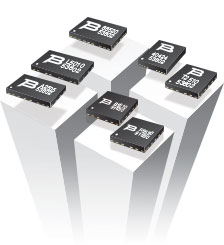
What transient surge events require a higher speed circuit protection device?
All electronic circuits need protection from surge events to prevent them from being reduced to landfill fodder. Surges can come from lightning, power induction events, electrical machine transient events, power cross events, earth potential rise (EPR), and automotive transient events.
Any transient surge entering an electronic circuit on a connected port can be reduced to a manageable level using a transient blocking unit (TBU) and one or more companion components. TBU® high-speed protectors (HSPs) are electronic current limiter (ECL) devices constructed using MOSFET semiconductor technology. They are specifically designed to trigger during large voltage or current transient events, providing an effective barrier that protects sensitive electronics.
How are TBU® HSPs different from other types of protection components?
TBUs® operate as a switch in series to stop the surge before it affects the protected load. In contrast, protection devices that shunt the surges, such as varistors, will display increased voltage at the highest currents. Other shunt components have imprecise breakdown voltages that can place a low impedance across the source. TBUs® detect current and trip within 1 μs when that current exceeds their preset trigger current, Itrigger. After triggering, 1.50 mA or less of quiescent current, IQ, leaks through at a specified voltage, usually 50 VDC. TBU® HSPs' MOSFET makeup lets them automatically reset without operator intervention when the surge has passed and voltage on the circuit falls below a specified level.
How do TBU® HSPs protect my circuit from excess voltage?
Excess voltage across the protected load is first detected by a tertiary protector—usually a transient voltage suppressor (TVS) or a TISP® thyristor surge protector. When the voltage surpasses the tertiary surge protector's breakdown voltage, the line is shorted out. This event pulls extra current through the secondary protector, the TBU® HSP.
The excess current triggers the TBU® HSP to act as a switch to disconnect the load from the high-voltage source. The time from detection to disconnection is less than 1 μs, so the load is disconnected before excess voltage or the resulting excess current can damage the protected circuit.
Do they also protect my circuit from excess current events?
A TBU® HSP device also works in high current surges. In these situations, the resistance across the device jumps from the specified RDevice—between 2.6 and 50 Ω—to a much greater resistance or impedance. This instantaneous impedance boost stops the current flow within the 1 μs timeframe.
Some load circuits require inrush current to start the load. For these, choose a TBU® HSP with Itrigger above that of the inrush current so that the load can start normally.
What do I need to consider when designing a coordinated circuit protection solution?
Properly selected, each of the components in the coordinated circuit protection solution protects the others. The primary protector—usually a metal oxide varistor (MOV) or gas discharge tube (GDT)—connects to the line coming in from the surge source and prevents damage due to extremely high surge voltage and current. Choose it based on the most likely source and current magnitude of the surge. For example: Is the surge a direct or indirect lightning bolt from a finger or from a 250 km3 cloud
The current-detecting TBU® HSP is the secondary protector that coordinates between the primary protector and the tertiary protector. Consider the let-through characteristics of the primary protector as well as the voltage, current, and duration of surge that the protected load can experience and survive.